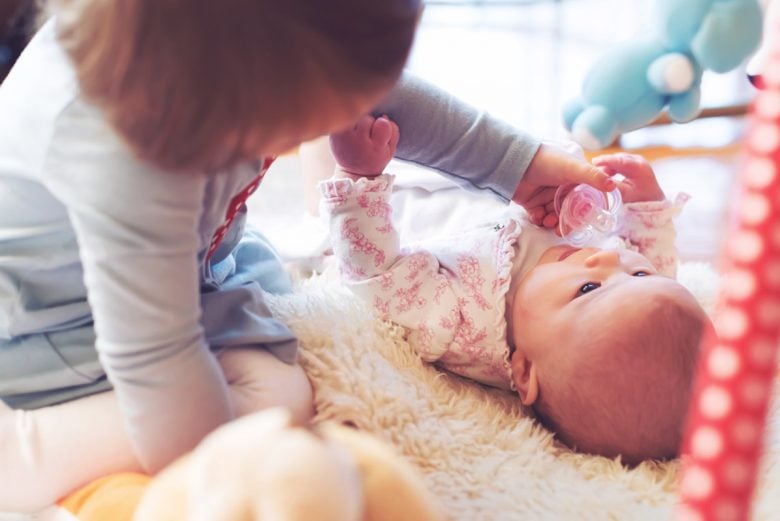
“Gentle.” “Be soft.” Do you get tired of repeating it?
Toddlers need coaching when interacting with babies. And most of the things parents try may actually just wear everyone out.
In this episode, Carol and Anne share tips to help all 4 Types of children interact with babies. You’ll find out why telling some kids to “be soft” will just backfire—and what you can say instead for better success.
This week’s Parenting Practice
Open your copy of The Child Whisperer book. Go to the end of the chapter for your child’s Type. Read the phrases for children 18 months to 3 years old. How well are you creating space for your child’s natural movement and curiosity? Make changes that call to you. Your toddler may naturally find more balance in how they interact with the baby.
Transcript of podcast episode
Anne: Quit pulling his hair. Like, you’re going to pull his hair out, and you’re bothering him.
Carol: Welcome to The Child Whisperer Podcast. I’m your host, Carol Tuttle, author of the bestselling parenting book, The Child Whisperer. I’m with my co-host Anne Tuttle Brown.
Anne: I’m a Type 3 mom with a three-year-old Type 3 daughter, and a six-month-old baby boy. My daughter loves her baby brother but has a hard time being soft with him. I know she’s capable of making better choices because she usually complies when I ask her to be soft with her friends. I’ve considered that maybe she enjoys getting a bigger reaction out of me when she’s too rough with the baby.
But it also seems that she enjoys her power over him as he is much smaller than she is. Time-out doesn’t work, but sometimes it seems the only solution is to keep them separated. Is this just how it is with a toddler and a baby? Or is there something else I can do to help her gently bond with her brother? Well, as a mom of a Type 3, she was about four when I had my second child. I relate to this, and I quickly realized that “soft” is not a word that she relates to. She’s a Type 3…
Carol: Did you try that…?
Anne:…Secondary 4 with a 1, and her last one would be a 2. So, soft is not her language.
Carol: She’s a Mini-Me.
Anne: Yes.
Carol: I’ve heard people tell me, “Calm down, Carol.” I’m like, “What is calm?” Balanced out, I would relate, too.
Anne: So, I just like, obviously, that’s what I was going for, was a more gentle baby type approach.
Carol: Did you use those phrases?
Anne: I changed my phrases to be something that would be more universal. That is her movement is just so rough, and swift, and charge-forward, that I called it baby touches, or just showed her how to touch that…and I would show her on her body, like, see how this, or on her baby dolls I would do a lot of role-playing. I would hit her baby doll really hard.
Carol: Right. This is behavioral training, really.
Anne: Mm-hmm.
Carol: You’re just knowing her. Instinctually, she’s going to move just pretty effortlessly, mindlessly like this. She needs to be taught to be mindful of her body language, and her movement now with a baby. So you weren’t…?
Anne: And Type 3…
Carol: Well, I just want to say what I love about your approach; you knew that it wasn’t intended to be aggressive.
Anne: Yeah.
Carol: She’s too young to have that sort of conscious intention. And then you recognized what would be natural for her wouldn’t be compliant with the baby. So, you had to teach her a really great start to her learning. There’s going to be a lot of opportunities in life for you to learn to manage who you are in a little bit different way. So, you’re mindful of what you’re choosing to do.
Anne: And I had to change my own mind what it would look like as far as what’s acceptable for her to touch the baby. Like, there definitely were things that made other people nervous when she was little and would hold him. But she has a great deal of self-confidence, and I would train her and teach her. And so, she at a young age…
Carol: She was picking up the baby when she was pretty young?
Anne: Yeah, four and a half she was carrying him around.
Carol: She actually became kind of helpful though at times?
Anne: And now she’s almost, you know, she was 6 when our third was born. So helpful. And I knew the limits like you can’t carry him up and down the stairs. I need to be here with you. But it would make my mother-in-law very nervous, “Is she okay? Is she okay?” I know her limits. I know what she can do. Also, she loves, it’s kind of a funny thing, she loves to, like, stroke her baby brother’s hair and, like, even pull it.
Carol: It’s not a stroke.
Anne: Well, this is what we’ve labeled it because…or in the early days it was, like, “Quit pulling his hair.” Like, “You’re going to pull his hair out. And it’s…you’re bothering him.” But that’s…and I feel like Type 3 little kids just…Oh, they just love the babies, and they just want to squeeze them, and they want to bite them, and they just want to be…They’re very physical. They are physically drawn to the world.
Carol: Their passion is coming out.
Anne: And they just…they don’t know how to hold back the roughness. And so that was one area where I was, like, “Okay, like, let me teach you. Obviously, like, you’re drawn to touching his hair. Let me teach you how to do it.” And there was a lot of correcting, but first, it was, like, “Don’t touch his hair, don’t touch his hair.” Then I was, like, “Maybe this is okay,” And I just trained her how to. And we call it stroking now. And she still does it. I mean, her baby brother is almost three.
Carol: Oh, I see it all the time.
Anne: And she’ll go up and kiss him, and she’ll pull his hair and…
Carol: That’s a thing for her. She’ll just be walking by him and notice him, and come right up and do that. That is the most frequent thing I’ve ever seen her do with her. “You’re the cutest little baby.” She’s really passionate about it, her little brothers.
Anne: Oh, she loves them. And so that it was kind of, like, a give and take between the two of, like, there are things that you…and I actually have a home video, and she picked up, he was probably 6 months at the time, picked him up, and she’s, “Rrr, Rrr,” Like, bouncing him up and down and I was, like, “Let’s be diligent” She’s like, “Why?” I’m like, “Well, he may not like that.”
But also I think that God wouldn’t have given me a Type 2 baby that couldn’t handle his bigger sister, too. You know, so I’m going to have to figure, like, it’s all going to work out. This all goes back to validating your child’s natural movement. If I’m constantly telling her to, “Stop, stop, stop, stop,” I mean, first of all, that’s exhausting for me. I get annoyed hearing my own self saying that so many times.
That’s why I was willing to make some compromises, and I’m teaching her who she is, and helping her, like you said, to manage it and coaching her. And so with all Types, you can use these phrases that we teach in The Child Whisperer book. You can help them to validate their movement while you’re using these phrases. So with Katie, it was, you know, a more…even though it was still more of a solid touch. Let’s just tweak it a little bit, so it’s not pounding, but it’s still solid. It’s still sturdy touches towards a baby.
A Type 1, they’ll naturally have more light touches. They also might be a little bit more bouncy, and a little bit connect-disconnect. So you’re going to want to watch it if they’re holding the baby. You know, I’m like, “Okay, change your mind.”
Carol: I like that idea that you had mentioned when we were preparing for this podcast that a Type 1 to encourage them to get the baby to laugh.
Anne: Yeah. Every Type has…
Carol: That’s a really good prompt for your Type 1 child to say, “Can you make the baby laugh?”
Anne: Mm-hmm, because they’re going to want to naturally interact with their siblings, and so what are they really good at, and what are the gifts that you can help them develop that also will be a benefit to you while you have this little baby? So Type 1s, you know, what silly faces can you make? What silly noises can you make? Can you copy the baby? Can you bring the baby toys? How can you get them involved in other ways in interacting with the baby?
With the Type 2, they’ll naturally be more soft and have cuddly touches. My Type 2 son was almost two when his little brother was born, and he was very cautious around him. He wasn’t naturally drawn to wanting to touch him. He took him some time to warm up to him. So, I think of all the Types, you’re probably not going to have an issue there. But if they are feeling a little bit, like, competitive there because now there’s a baby that’s taking Mom’s attention, they could resort to attacking, or, you know, doing little things, taking the toys away, or making the baby upset in a very more passive, subtle way. So watch for that.
But a gift that the Type 2 would have is they’re so good at making the baby feel loved or comforted, and knowing their favorite things, or sharing their special blankets, and creating that safe, loving feeling, or even helping prepare the baby for the bed, or get the diapers ready kind of in those preparations. Type 3 we talked about. They are just so good at being a good helper, and really helping build them up. How could this little girl become a really good helper for her baby brother? And so are there things where she could always help get the diaper, get the food and make it a fun part of responsibility?
The Type 4, I would say, prepare in advance before the baby comes, a lot. So, my sister-in-law has a Type 4 oldest son, and before her second baby was born, she got him a baby doll, and they would do a lot of practicing and preparation. And that made him feel more confident and excited for the baby to come.
Carol: What you’re recommending for each of these is to have a mindfulness of your child’s natural movement. So you’ve gotten… I think the adjectives we use are constant reminders. We tend to just use Type 1, Type 2, Type 3, Type 4. What if you replace that with Fun-loving child, Sensitive child, Determined child, More-Serious child? That’s a reminder to constantly tell yourself, “My child is going to approach this experience true to their nature. I have an opportunity to coach them to learn some behavioral skills that are appropriate in interacting with the new baby in the household.”
And children are very willing, and they especially will be encouraged by a lot of praise, recognition. So, are you spending more time correcting what you don’t want hoping that what you do want kind of materialize from that? Well, if you’re putting all the emphasis on what you don’t want, and the correction, your child is not being given a replacement. All they know is, “I shouldn’t be doing this, but I don’t know what else to do.”
What your approach showed was showing them immediately what to do. In fact, you could pre-empt the baby arrival with every Type being able to practice with a doll and to teach them knowing they’re going to do this. It’s who they are. So, let’s prepare them to have a successful interaction that I can praise, praise, praise, praise because once praises given, that imprints in their mind. That’s good. That’s valid. That feels right. I’m honored for that. I’m going to repeat that so that repetition will kick into place. But I really love your idea of that preparatory phase and taking into account what, of course, they’re going to do that. Don’t be so thrown by it. Like, what’d you expect? Of course, they will. It’s how they live their life.
Anne: Again, I don’t expect a three-year-old to know how to treat a baby. The instant the baby arrives, there’s gotta be a lot of coaching there. I want to share another example about how I validated my child’s movement outside of the example of how to treat a baby. And this is just another way to, you know, expand your horizons, I guess, I will say. Like you think kids are only safe doing a certain thing, while as a Type 3 they might be able to do a little bit more.
My daughter would love to jump from bed to bed or jump from stairs down into a pile of pillows. And one time she was, like, five stairs up, then six stairs up. And I’m like, “That’s too high.” And she’s, like, “I can do it, mom.” She’s three-years-old, and she has her blanket tied around her neck, like, a superhero cape, and we have a big pile of pillows.
And I was, like, “Okay, well, here they are,” And there were enough pillows and she was going to be okay, but she jumped, and she had a great time. And there were just many times, especially in this three-year-old phase where I’m, like, “I don’t know that might be risky.” But helping her, being there for her, but kind of letting her lead the way really helps validate her big movement that’s prone to take a little more risk. In The Child Whisperer book, Carol, you have put the primary emotional need for the different phases of life for a child, and a toddler, which is 18 months to three years, the primary emotional need is a support in sensing, exploring, and doing in the world. And that makes sense. If you think of a child that’s 18 months to three-years-old, they’re very curious.
They’re busybodies. They’re moving. They may be getting into trouble climbing on the counters, or, you know, touching the baby too hard. They’re exploring, and they’re using their hands to do that. So, messages that your child needs to hear, in this stage of life, “It’s okay to be curious, to move, to touch and explore.” So, ask yourself this question, “Could your child say it is okay to be curious, to move, to touch and explore? Or, have you put too many boundaries in place where they’re not able to do that in a safe way? We will make it safe for you to explore. Have you done that? You can be you, and we will always love you. Are you feeling that? You can try out new things, and find your own way of doing things. It’s okay for you to want to move forward, and trust that your parents will support you in doing what’s best for you.”
Your parenting practice this week is to read through those phrases, 18 months to three-years-old, and do an evaluation on how well you are creating a space for your child to explore, and be curious, and make some changes as you feel prompted to do so. So that your child in this phase of life can really be validated for who they are in their natural movement.
Carol: Thanks for listening. For more support, go to thechildwhisperer.com, where you can purchase the book, subscribe to our weekly parenting practice email, and find a transcription and audio of the child whisperer podcast.
Anne: If you’re listening on iTunes, thank you for leaving a review. If you have a parenting question, please send it to [email protected].



